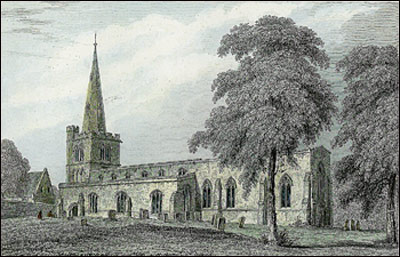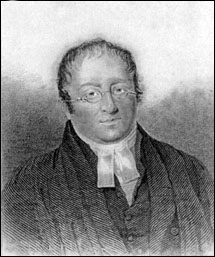|
|||||
|
|||||
|
During the early 19th century, it seemed to be the practise for burial of non denominational residents to be buried in the church graveyard with the service undertaken by an alternative minister from that religion, and not the Rector of St Marys. This was known as internment of Dissenters. These internments took the form of dissenting minister preceding the corpse to the grave through the churchyard and singing a hymn over the remains. After this he would retire outside the church grounds to offer up a prayer and deliver his address. these services were often at the request of the deceased family or friends, where they applied to the incumbent Clergyman to desist from performing the funeral service as the deceased when alive was a Dissenter. One such incident occurred at St marys Church, Burton Latimer in October 1835. The Rector of St Marys at this time was Thomas Grimshaw. During his time at Burton Latimer, Rev. Grimshaw built very good relations with the Baptist Church and its ministers. After this incident had occurred and been reported in the "Northampton Herald", the Rector wrote to the newspaper informing them of his decision to contact the eminent authority on such matters, Dr Lushington, for advice. Rev. Grimshaw outlined the main points of dispute and confusion with regard to the internment of Dissenters. Firstly - what is the law if there is no burial ground attached to the Dissenting place of worship? Secondly - where the friends of the deceased think proper to dispense with the services of the Clergyman and the Dissenting Minister is desired to perform the ceremony, can the Dissenting Minister claim the right of preceding the corpse to the grave within the churchyard, seeing it deposited then singing a hymn over the remains before retiring from church ground to complete the service? In this case the Dissenting minister was a Baptist, and he too was unsure of the situation, so for both parties to fully understand the law and be guided by this in future circumstances, the Baptist Minister also submitted his concerns which were of a similar nature to Rev. Grimshaw. Dr Lushington replied some weeks later. On the first point he gave the opinion that the law recognises no distinction as to the burial of Dissenters, unless the deceased has not been baptised. It is the duty of the incumbent minister is to bury the corpse with the usual funeral service, without regards to the whether when alive the person was a Dissenter or not. If the friends and family of the deceased apply for the clergyman to abstain from perfroming the funeral service, then the incumbent Clergyman can comply with such a request. However, the Dissenting Minister cannot assume this role, although he may still offer prayers and deliver his address outside the walls. Secondly, It is true that the freehold of the churchyard generally rests with the incumbent. The ground is consecrated for divine offices according to the rites of the Church of England, and the incumbent has the sole right as well as the duty of performing such offices. Even a Clergyman episcopally ordained could not perform any ceremony within the churchyard without the leave of the incumbent. Dr Lushington considered that the only people who have authority to perform any description of funeral rite within these boundaries was the incumbent or other Clergyman of the Church of England (with his permission), and this can only be a rite sanctioned by the church.
|
|||||

